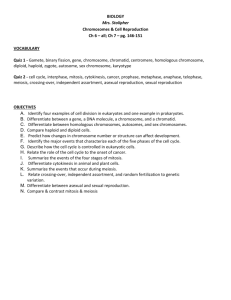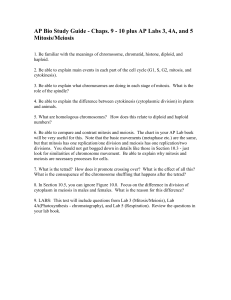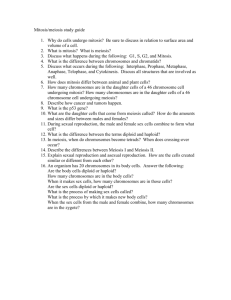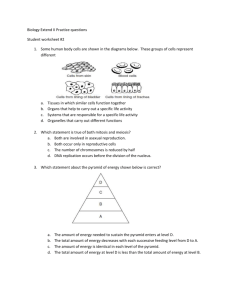Ch. 9 -- Mitosis/Meiosis
advertisement
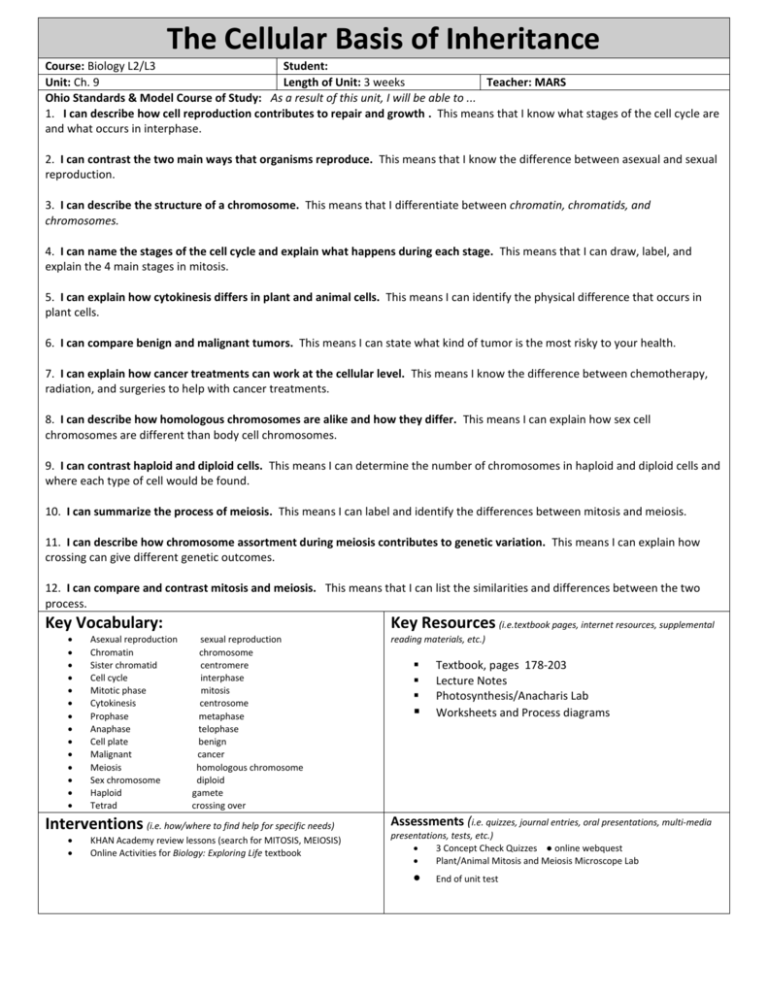
The Cellular Basis of Inheritance Course: Biology L2/L3 Student: Unit: Ch. 9 Length of Unit: 3 weeks Teacher: MARS Ohio Standards & Model Course of Study: As a result of this unit, I will be able to ... 1. I can describe how cell reproduction contributes to repair and growth . This means that I know what stages of the cell cycle are and what occurs in interphase. 2. I can contrast the two main ways that organisms reproduce. This means that I know the difference between asexual and sexual reproduction. 3. I can describe the structure of a chromosome. This means that I differentiate between chromatin, chromatids, and chromosomes. 4. I can name the stages of the cell cycle and explain what happens during each stage. This means that I can draw, label, and explain the 4 main stages in mitosis. 5. I can explain how cytokinesis differs in plant and animal cells. This means I can identify the physical difference that occurs in plant cells. 6. I can compare benign and malignant tumors. This means I can state what kind of tumor is the most risky to your health. 7. I can explain how cancer treatments can work at the cellular level. This means I know the difference between chemotherapy, radiation, and surgeries to help with cancer treatments. 8. I can describe how homologous chromosomes are alike and how they differ. This means I can explain how sex cell chromosomes are different than body cell chromosomes. 9. I can contrast haploid and diploid cells. This means I can determine the number of chromosomes in haploid and diploid cells and where each type of cell would be found. 10. I can summarize the process of meiosis. This means I can label and identify the differences between mitosis and meiosis. 11. I can describe how chromosome assortment during meiosis contributes to genetic variation. This means I can explain how crossing can give different genetic outcomes. 12. I can compare and contrast mitosis and meiosis. This means that I can list the similarities and differences between the two process. Key Vocabulary: Asexual reproduction Chromatin Sister chromatid Cell cycle Mitotic phase Cytokinesis Prophase Anaphase Cell plate Malignant Meiosis Sex chromosome Haploid Tetrad Key Resources (i.e.textbook pages, internet resources, supplemental sexual reproduction chromosome centromere interphase mitosis centrosome metaphase telophase benign cancer homologous chromosome diploid gamete crossing over Interventions (i.e. how/where to find help for specific needs) KHAN Academy review lessons (search for MITOSIS, MEIOSIS) Online Activities for Biology: Exploring Life textbook reading materials, etc.) Textbook, pages 178-203 Lecture Notes Photosynthesis/Anacharis Lab Worksheets and Process diagrams Assessments (i.e. quizzes, journal entries, oral presentations, multi-media presentations, tests, etc.) 3 Concept Check Quizzes ● online webquest Plant/Animal Mitosis and Meiosis Microscope Lab End of unit test


